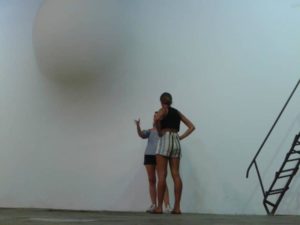I got to Havana airport at 17.40 of 6th September 2018. The flight, spent between a packet of paprika taralli and a dressed tomato juice, a drink that for some reason I only feel like drinking during flights, felt surprisingly quick. A heavy wave of extremely hot and humid air welcomes me just outside the plane. The airport is a modest building, grey-reddish, looking like a warehouse of unsold pickles without hope of that ever happening.
Claudia Gonzàlez, who will become my guide, friend and inspiration throughout my stay, is waiting for me at arrivals; we vaguely look at each other, and we understand that we are looking for one other. We meet, we immediately click, and whilst chatting we board a beautiful red “almendron”, a term used for historic American cars, while David, the driver and a friend of Havana’s Third Paradise group, listens to us and drives.
The journey from the airport to my home-to-be for the 3 weeks lasts about 30 minutes. Drawn to the fullness of the roads, the predominance of green around me, the continuous movement and the faces of my future fellow havaneri, I look out of the car window and listen to Claudia telling me about her world.
We arrive at Playa, the area in which I will live as a guest of Caruca and Marianela, grandmother and mother respectively of Laura Redondo, the Third Paradise project collaborator who has made my trip to Cuba possible with her mediation.
The plan for the next day is to change Euros into Cuban money, which consists of Cuc, or Cuban Dollars, and Cup, pesos Cubanos, the national currency. A Cuc is the equivalent of 26 Cups. I also need to buy a Cuban SIM and a “tarjeta” to be able to connect to internet, being wi-fi available only in a few parks and hotels. After that we will go for lunch with Gaby Pais, Claudia’s compagnera in the Third Paradise project. At the exchange bureau euro are not in stock, since each banknote leaving the bank comes from the street, from Cuban people, from their activities and barters. We therefore leave it to the following day, and we head to the office of Etecsa, the only Cuban telecommunication provider. Outside the entrance door a 100-metre long queue extends dauntless, almost aggressive, proud to be that long. The system has collapsed. No Cuban SIM, not today.
Throughout lunch Claudia and Gaby explain to me that the 1976 constitution will soon be modified to acknowledge homosexual couples, the presumption of innocence in trials and private property. Cuban citizens are formulating their proposals as we speak; they meet and discuss in neighbourhood assemblies. Claudia tells me about an old lady from her area who, at the question “What doesn’t work in Cuba?”, had raised her hand and heavily leaning on her walking stick had said: “Fags bother me.” They also tell me about the American migratory deal “dry feet and wet feet” – established in 1995 and revoked by Barack Obama a few hours before his resignation – : who gets captured at sea is sent back, who manages to reach dry land is entitled to asylum in the US. They tell me that people they know embarked on this illegal crossing towards the shore of the country where dreams are reality, and how the coastal guards kept them for days in inhuman conditions just 7 miles off the coast of America, waiting for other boats, other Cubans to take back home. They tell me about the cultural and symbolic long wall erected on the coast of Havana, “El Malecòn”, of the sense of protection it confers and the sense of isolation it imposes.
Today is the 10th September. Claudia and I are going to the Arte Continua gallery, in Havana’s Barrio Chino. After introducing me to the space (the former cinema Aguila de Oro) and to the exhibition, its director Luisa Ausenda takes us for lunch to an “authentic” Chinese restaurant, where she tells us about how she got to Havana by herself, from Istanbul, where she used to work for a contemporary art gallery. She is enthusiastic, she speaks quickly and clearly about the exhibition coming up and the participatory artistic project she is starting. From 22nd September 2018 the gallery will host the exhibition “¿Còmo està el agua?”, composed of visual and sound installations by 9 Cuban artists. On the same day the programme PASE poesia, arte y sonìdo esperimental will open.

That same afternoon, Luisa and I go to an event part of the cultural project “San Isidro, Distrito de Arte”, in the San Isidro neighbourhood. There we find Cuban artists, musicians and performers living in the area, and a clothing label called “Clandestina”. They are all gathered in the Barrio’s main square, some printing t-shirts and doing body-painting. They drink fruit juice from a cart with a fridge which seconds before had been a prop in Martica Minipunto’s sparkling performance. The afternoon turns into the evening and a big stage is installed in the middle of the square surrounded by decrepit 19th century buildings. The musicians tune their instruments and the show starts.
(End of part one – please click here for part two)

